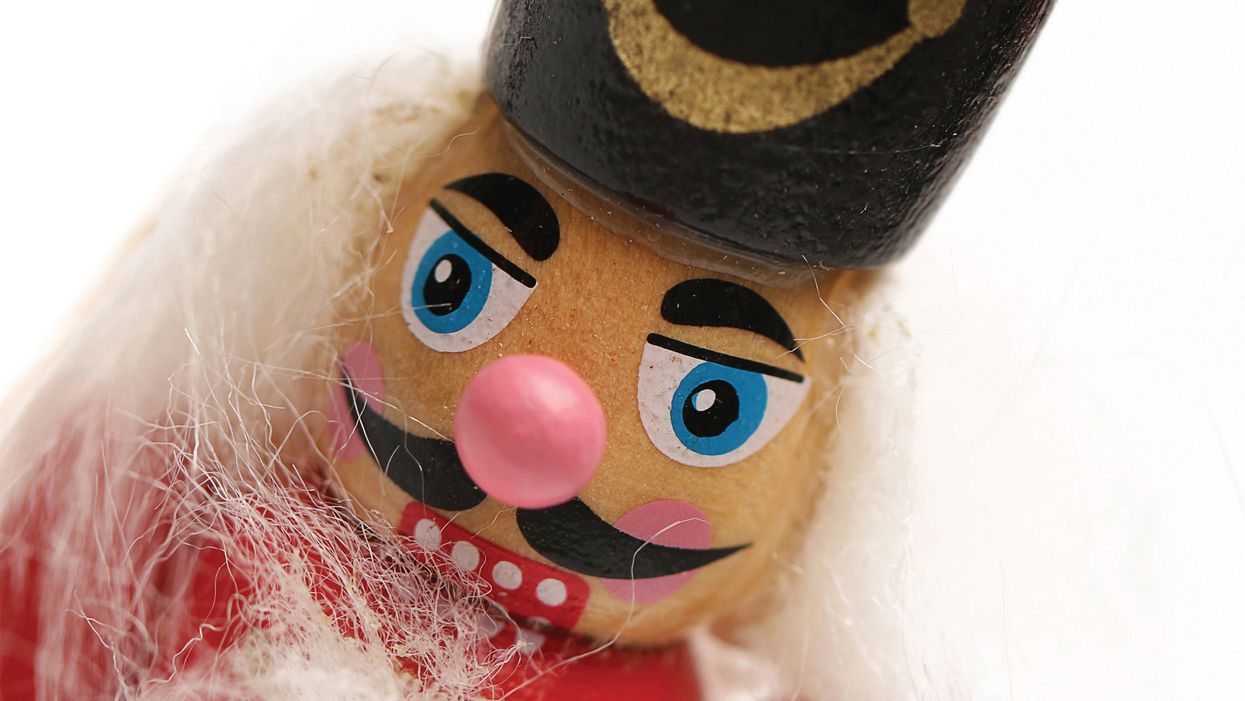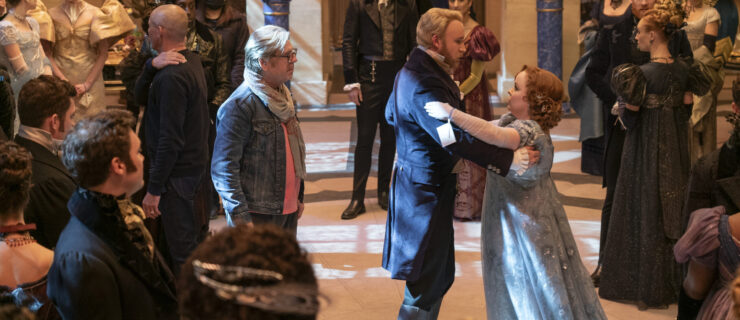The Nutty History of "The Nutcracker"
The Nutcracker has become an essential part of the holiday season—not to mention a part of most dancers’ DNA. These days, the ballet is a beloved tradition, and the lifeblood of many dance companies, whose budgets depend on its reliably great ticket sales. But did you know that it was a flop when it first premiered in Russia? Or that George Balanchine himself once played Drosselmeyer on TV? Here’s a timeline of the rich history of The Nutcracker.
1816
 Getty Images
Getty Images
E.T.A. Hoffmann writes the fairy tale Nutcracker and Mouse King—and it is dark. The story follows a young girl, Marie, who travels to the Land of Toys to help her beloved Nutcracker defeat a seven-headed Mouse King with brainwashing powers(!).
1845
French writer Alexandre Dumas adapts Hoffmann’s work into The Tale of the Nutcracker, a lighter take on the story that would become the inspiration for the ballet.
1891
Pyotr Ilyich Tchaikovsky begins to compose The Nutcracker, the last of his three ballets (after Swan Lake and The Sleeping Beauty). While traveling in Paris, he discovers a new bell-toned instrument called the celesta, which he ends up using for the iconic Sugar Plum Fairy variation. Marius Petipa begins to choreograph the ballet, but becomes ill during the process. Mariinsky Ballet ballet master Lev Ivanov completes the choreography.
1892
 Getty Images
Getty Images
The Nutcracker
premieres at the Imperial Mariinsky Theater in St. Petersburg, Russia, with the role of the Sugar Plum Fairy danced by Italian ballerina Antoinetta dell’Era. Though selections from the score were well-received in concert a few months earlier, critics call the ballet “an insult,” and it’s quickly removed from the company’s repertory.
1893
Tchaikovsky dies without knowing what a success his holiday ballet would become.
1940
 Courtesy All CDCovers.com
Courtesy All CDCovers.com
Walt Disney includes music from Tchaikovsky’s score in the animated movie Fantasia, helping American audiences get to know (and fall in love with) The Nutcracker‘s music. The Ballet Russe de Monte Carlo tours the United States with a condensed version of The Nutcracker. The performances are well-received, and the Ballet Russe continues to dance its abbreviated Nut in the U.S. for the next decade.
1944
 San Francisco Ballet in the first version of “The Nutcracker” (courtesy Dance Magazine Archives)
San Francisco Ballet in the first version of “The Nutcracker” (courtesy Dance Magazine Archives)
The San Francisco Ballet presents the first complete version of The Nutcracker in the United States, choreographed by William Christensen and premiering on Christmas Eve. While choreographing, Christensen seeks the advice of ballerina Alexandra Danilova and choreographer George Balanchine, both of whom danced in the original Nutcracker production at the Mariinsky.
1953
Balanchine, now leader of the New York City Ballet, is asked to edit out the dramatic growing tree from his new production of The Nutcracker due to budget constraints. He refuses, saying, “No, ballet is the tree.”
1954
 Maria Tallchief (original Sugarplum) and Erik Bruhn in NYCB’s Nutcracker (courtesy Dance Magazine Archives)
Maria Tallchief (original Sugarplum) and Erik Bruhn in NYCB’s Nutcracker (courtesy Dance Magazine Archives)
NYCB premieres Balanchine’s version of The Nutcracker, starring Maria Tallchief as the Sugarplum Fairy and featuring many dance quotations from the Mariinsky original. The show—Balanchine’s first full-length production for the company—is an instant sensation.
1957
 Balanchine (right) coaching dancers for the 1957 TV production of “The Nutcracker” (courtesy Dance Magazine Archives)
Balanchine (right) coaching dancers for the 1957 TV production of “The Nutcracker” (courtesy Dance Magazine Archives)
CBS airs Balanchine’s Nutcracker on national television. Balanchine himself plays Drosselmeyer, Diana Adams is the Sugarplum Fairy, and Allegra Kent dances Dewdrop. The television coverage exposes an even wider audience to the irresistible show.
1964
 Photo by Joe Buglewicz, courtesy NYC & Company
Photo by Joe Buglewicz, courtesy NYC & Company
New York City Ballet performs The Nutcracker at their new Lincoln Center home for the first time. George Balanchine has the New York State Theater’s stage specially constructed to accommodate the tree, which grows from 18 to 41 feet (and weighs 2,200 pounds!)
1983
 Lindsi Dec and William Lin-Yee as Clara and the Nutcracker Prince in Pacific Northwest Ballet’s Maurice Sendak production (photo by Angela Sterling, courtesy PNB)
Lindsi Dec and William Lin-Yee as Clara and the Nutcracker Prince in Pacific Northwest Ballet’s Maurice Sendak production (photo by Angela Sterling, courtesy PNB)
Pacific Northwest Ballet premieres Kent Stowell’s version of The Nutcracker, a collaboration with Where the Wild Things Are author Maurice Sendak. The production, with imaginative designs by Sendak, explores more of the emotional torment of the original story; ultimately, Clara is left behind in The Land of Sweets. (In 2014, PNB retires the Sendak production and begins performing Balanchine’s version.)
1991
 Mark Morris Dance Group’s “The Hard Nut” (photo by Julieta Cervantes, courtesy Mark Morris Dance Group)
Mark Morris Dance Group’s “The Hard Nut” (photo by Julieta Cervantes, courtesy Mark Morris Dance Group)
Mark Morris premieres The Hard Nut, an offbeat take on the original Hoffmann tale that includes some of the narratives edited out of the traditional ballet. He sets his version in the 1970s United States, and adds modern toys (like GI Joes) and retro designs inspired by the work of comic book artist Charles Burns.
1994
 Macaulay Culkin (far right) and Darci Kistler in the 1994 NYCB “Nutcracker” film (courtesy Dance Magazine Archives)
Macaulay Culkin (far right) and Darci Kistler in the 1994 NYCB “Nutcracker” film (courtesy Dance Magazine Archives)
Home Alone
‘s Macaulay Culkin, then a student at the School of American Ballet, plays the Nutcracker prince in Emile Ardolino’s film version of Balanchine’s Nutcracker.
1996
Donald Byrd premieres The Harlem Nutcracker, featuring Duke Ellington and Billy Strayhorn’s jazzy arrangement of Tchaikovsky’s score. Celebrating the American black family, it features Clara as a widowed grandmother.
2013
NYC’s Department of Cultural Affairs reports 27 productions of The Nutcracker in the Big Apple alone.
Today
Dance companies around the world continue to perform hundreds of productions of The Nutcracker each year, and audiences continue to flock to them. Nut ticket sales account for nearly half of many dance companies’ annual income.
A version of this story appeared in the December 2018 issue of Dance Spirit with the title “The Fascinating (And Sometimes Nutty) History of The Nutcracker.“




